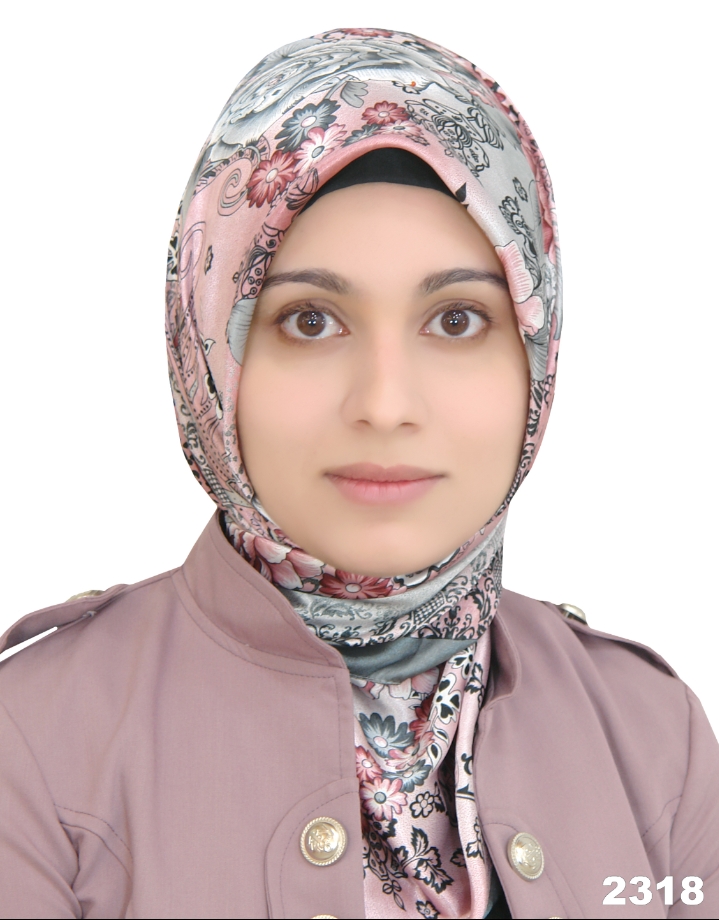
Asan ihsan ABAS
Research InterestsMedical image processing
Signal processing
Multi-source image processing
Optimization algorithms
Deep Learning
| Gender | FEMALE |
|---|---|
| Place of Work | Technical Engineering College/ Kirkuk |
| Department | Department of Medical Instrumentation Techniques Engineering |
| Position | Lecturer |
| Qualification | Ph.d |
| Speciality | Software Engineering |
| asan.ihsan24@ntu.edu.iq | |
| Phone | 0000000 |
| Address | Kirkuk, Kirkuk, Kirkuk, Iraq |
Skills
Image processing (89%)
Deep learning (80%)
Artificial intelligence (80%)
Remote sensing image processing (90%)
Nural network (75%)
Medical image processing (85%)
Matlab (87%)
Software engineer (80%)
Academic Qualification
M.Sc in Computer Engineering - Selcuk University
Sep 16, 2009 - Jul 1, 2011The Master Research focused on Remote sensing image fusion using different mathematical transform domains achieve high quality satellite image fusion
Ph.D. in Software Engineering - Ege University - Selcuk University - Konya Technical University
Jun 1, 2016 - Jan 21, 2023PhD RESCEARCH FOCUSED ON MULTI-SOURCE IMAGE FUSION USING METAHEURISTIC ALGORITHMS AND
DEEP LEARNING
B.Sc in Software Engineering-Northern Technical University
Feb 1, 2004 - Jun 15, 2007Working Experience
Computer [Lecturer]
Sep 1, 2011 - Feb 28, 2013College of Engineering at Kirkuk University and College of science at kirkuk University
Artificial intelligence, Deep Learning, Metaheuristic Algorithms, Image processing [Lecturer]
Jan 1, 2011 - PresentPublications
Medical image fusion with convolutional neural network in multiscale transform domain
Aug 9, 2021Journal Turkish Journal of Electrical Engineering & Computer Sciences
publisher TUBITAK
Issue 8
Volume 29
Multimodal medical image fusion approaches have been commonly used to diagnose diseases and involve merging multiple images of different modes to achieve superior image quality and to reduce uncertainty and redundancy in order to increase the clinical applicability. In this paper, we proposed a new medical image fusion algorithm based on a convolutional neural network (CNN) to obtain a weight map for multiscale transform (curvelet/ non-subsampled shearlet transform) domains that enhance the textual and edge property. The aim of the method is achieving the best visualization and highest details in a single fused image without losing spectral and anatomical details. In the proposed method, firstly, non-subsampled shearlet transform (NSST) and curvelet transform (CvT) were used to decompose the source image into low-frequency and high-frequency coefficients. Secondly, the low-frequency and high-frequency coefficients were fused by the weight map generated by Siamese Convolutional Neural Network (SCNN), where the weight map get by a series of feature maps and fuses the pixel activity information from different sources. Finally, the fused image was reconstructed by inverse multi-scale transform (MST). For testing of proposed method, standard gray-scaled magnetic resonance (MR) images and colored positron emission tomography (PET) images taken from Brain Atlas Datasets were used. The proposed method can effectively preserve the detailed structure information and performs well in terms of both visual quality and objective assessment. The fusion experimental results were evaluated (according to quality metrics) with quantitative and qualitative criteria.
Multi-Focus Image Fusion with Multi-Scale Transform Optimized by Metaheuristic Algorithms
Mar 20, 2021Journal Traitement du Signal
publisher International Information and Engineering Technology Association (IIET)
Issue 2
Volume 38
Focus is limited and singular in many image capture devices. Therefore, different focused objects at different distances are obtained in a single image taken. Image fusion can be defined as the acquisition of multiple focused objects in a single image by combining important information from two or more images into a single image. In this paper, a new multi-focus image fusion method based on Bat Algorithm (BA) is presented in a Multi-Scale Transform (MST) to overcome limitations of standard MST Transform. Firstly, a specific MST (Laplacian Pyramid or Curvelet Transform) is performed on the two source images to obtain their low-pass and high-pass bands. Secondly, optimization algorithms were used to find out optimal weights for coefficients in low-pass bands to improve the accuracy of the fusion image and finally the fused multi-focus image is reconstructed by the inverse MST. The experimental results are compared with different methods using reference and non-reference evaluation metrics to evaluate the performance of image fusion methods.
Conferences
Remote sensing image fusion using transform domain based on optimization algorithms
Nov 25, 2020 - Nov 26, 2020Publisher Intercontinental Geoinformation Days
Country Turkey
Location Mersin University









